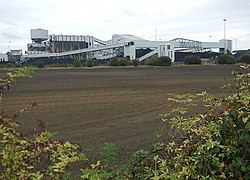Kellingley Colliery

Kellingley Colliery
|
|
| Location | |
|---|---|
| Location | Beal, North Yorkshire |
| District | Selby |
| Country | England |
| Coordinates | 53°42′19″N 1°12′24″W / 53.70534°N 1.20661°WCoordinates: 53°42′19″N 1°12′24″W / 53.70534°N 1.20661°W |
| Production | |
| Products | Coal |
| History | |
| Opened | 1965 |
| Closed | 2015 |
| Owner | |
| Company | UK Coal |
| Website | UK Coal |
| Year of acquisition | 1994 |
Kellingley Colliery was a deep coal mine in North Yorkshire, England, 3.6 miles (5.8 km) east of Ferrybridge power station. It was owned and operated by UK Coal.
The colliery closed on 18 December 2015, marking the end of deep-pit coal mining in Britain.
Exploratory boreholes sunk in the 1950s established that there were up to seven workable seams of coal at Kellingley. The sinking of its two shafts started in 1960. Its sandy and porous geology down to about 600 feet (180 m) was waterlogged. Boreholes drilled around each shaft position had sub-zero-temperature brine pumped through them to freeze the ground down to about 640 feet (200 m). The sinking personnel had to work in subzero temperatures until the shafts were below this frozen ground. The shafts were eventually sunk to a depth of around 870 yards (800 m).
After a concrete lining sealed the shafts, the cooling brine was stopped and the frozen ground allowed to thaw. Grout, a thin cement mixture, was pumped at high pressure through holes bored through the shaft's concrete lining into the water-bearing strata. When it set, most of the water leaking into the shafts was stopped and the ground around the upper part of the shafts was stabilised.
The pressure needed to pump in the mixture caused the ground above to heave, causing the winding engine towers mounted above the shafts to tilt slightly. This had been anticipated and provision had been made to jack up the four legs that each tower stood on. The procedure was done regularly during the pumping phase to bring the towers into alignment. To keep the shafts to the correct alignment, plumb lines were used. Four steel lines, evenly spaced, were suspended around the inside of each shaft, all the way to the bottom.
The colliery began production in April 1965. During planning and building the surface infrastructure for the new colliery, employment of 3,000 mineworkers was expected at completion. Because of updated methods and machinery, only about 2,000 men were employed there at any one time. Many of the miners relocated from Scotland to work at the colliery, having lost their jobs at Scottish pits that closed in the 1960s. In March 2004, the pit received £7.2 million from the Coal Investment Aid Scheme.
Kellingley’s two main shafts were each almost 870 yards (800 m) deep. One was used to move men and materials, and the second to move coal from the Beeston seam, at a rate of up to 900 tonnes an hour. Kellingley primarily supplied local power stations. It also produced some housecoal-quality coal: larger-sized coals of higher calorific value.
...
Wikipedia

